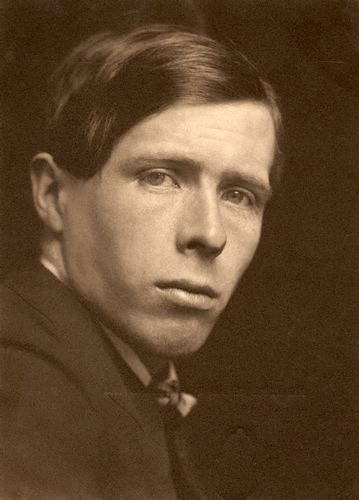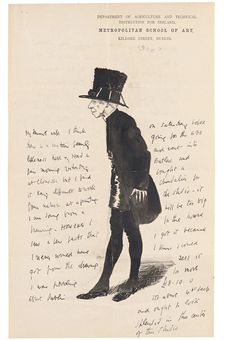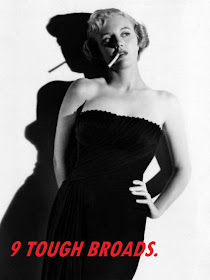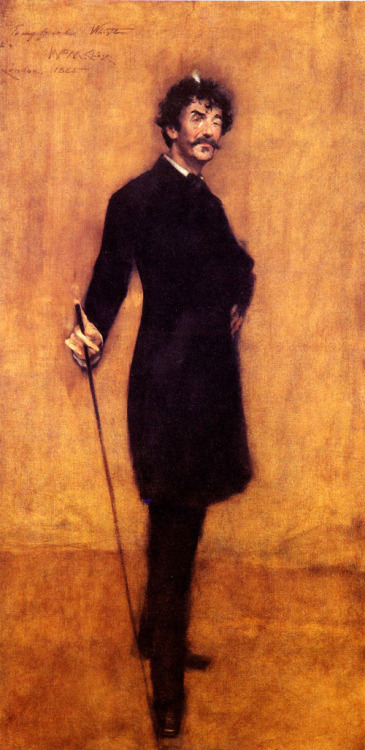This would have been
Ten Tough Broads, except that Google continues to deny me access to any photo links. Hopefully when daughter returns from a trip, she'll be able to straighten things out for me. The photos I've used on this post were stored by me in a file a while back.
**************************
9 Tough Broads.
You know who I mean - movie dames so tough they spit bullets. Not the major stars who were known for their impenetrable on-screen veneer:
Toughies like
Joan Crawford (the toughest of them all, merely a lift of those indelible eyebrows was enough to get a hernia going ),
Bette Davis (no slouch herself, less obvious than Joan, she had
The Voice that could eviscerate a man at twenty paces)
Barbara Stanwyck (she had honed the sneer to perfection), even
Jane Russell and
Lana Turner.
All were tough movie dames. All were stars of the first tier. Broads of the first water. (And I mean that in the best possible way.)
But today's post is about some second tier toughies, all battle-scarred (figure of speech), all veterans of the double-cross, all wise to the use of the coup de grace, all fine-tuned to the ways of men.
My nine are just not as well known as the stars I listed above, they are nine who didn't quite make it into the Abestos Hall of Fame.
I had added
Rita Hayworth to the stars mix, but then decided she was tough, yeah, but she was too soulful, too often the object of heartbreak, too
glammed up to commandeer a sub-machine gun and take out a nest of bad guys (or good) without chipping a nail. Same for
Ava Gardner.
The following, then, are my choices for the toughest of the tough - women with dollar signs for hearts, women who think nothing of flipping off the geek who served them with devotion, think nothing of scorning true love for great sex. Women who could shoot to kill with and without a gun, but never without a manicure.Women who were occasionally good enough, but more often bad enough.
Now before anyone takes umbrage or accuses me of besmirching the memory of a good woman, I am
ONLY talking about
the screen presence of these beautiful creatures who were born, more or less, to slink their way into bad-girl movie history. Maybe not strictly Hall of Fame material, but close enough.
Gloria Graham
Gloria Graham was and always will be (at least for me) the epitome of the tough broad. She just had that sleepy look about her that told you a thing or two without uttering a word. She had a tough as nails glossy exterior and a low-key way of making herself understood, speaking softly, barely without
moving her mouth. (I believe she'd had some kind of surgery that had gone wrong or something. But it just added to her on-screen allure.)
Even when she played good, she played bad, if you know what I mean. No one would ever mistake her for a member of the PTA - at least on screen. Borderline sleazy, she was really quite wonderful in just about anything she did. She had the strange ability to make men quiver and yet, women liked her.
Go figure.
To learn about Gloria Graham and her films, please use this link.
Marie Windsor
Now,
Marie Windsor was a different kettle of...uh, fish. She wasn't breaking her heart over anyone - she was there to stomp on hearts and to hell with the debris. I know no woman who can honestly say they liked Marie on-screen. Her film persona was just too brittle, too hard-edged. You'd pour your soul out to her and she'd sell you down the river for a couple of dollars and some bling.
Can't help it, that's the impression she always gave. She meant business with a capital B. In films she was usually the gal friend of the swarthy guy who owned the local gambling hall, nightclub, bar, dance hall, carnival or strip joint. Though in the end she was usually left holding the bag while the head honcho went on to greener pastures with the young innocent do-gooder who'd caught his jaded eye, you knew Marie would live to connive another day. The cigarette in the fancy holder told you that much.
Marie had been around the block one too many times and often looked it. She had a steely glitter in her googly eyes which would, of course, instantly put another woman on guard. Not that it actually ever got her anywhere, since in most movies she usually wound up dead or dumped. But while she had the upper hand, she enjoyed the heck out of it.
I'll bet in reality she was a sweetheart, but we're talking
film persona now.
To learn about Marie Windsor and her films, please use this link.
Jan Sterling
Poor
Jan Sterling, she was almost always doomed to play dumb but shifty. I don't think I ever saw her in a movie where there was much going on behind the sultry, vacant stare. (As my daughter would say, the hamster must have left the wheel untended.)
Jan's characters were always ready to believe anything a man told them and were cruelly disappointed (every damn time) when the inevitable double-cross landed her in the gutter (literally, in UNION STATION), in the arms of the law or on a slab in the morgue.
You had to feel sorry for her, you really did. The minute she slinked onscreen, it was
'uh-oh' watch out, this one's gonna' get it. All you had to do was wait for the inevitable. And every single time it came as a total surprise to Jan. I think it was all the peroxide.
To show you how the camera can distort reality, Sterling was born to a well-to-do family and educated in Europe. So much for verisimilitude.
To learn about Jan Sterling and her films, please use this link.
Joan Blondell
Joan Blondell was always the hussy with the heart of gold. She was tough, she could dish it out, she knew the score, but when push came to shove, she did what the second banana usually did, she took the fall for the leading lady who usually had much less on the ball than she did. But again, it was the screen persona.
Even when she wasn't really a gold-digger, Warren Williams thought she was and treated her like it. Even when she was just there as girl-friend back-up to Carole Landis, Joan is the one who gets killed instead. True, she comes back as a ghost to frolic with Topper (in TOPPER RETURNS) and hunt for her killer, but still...
Joan always looked as if she worked at the local burlesque joint and didn't care who knew it. Yet she had a motherly vibe about her that made it impossible for anyone to dislike her.
She seemed to know every snappy one-liner ever written and wasn't shy about spitting them out. I loved Joan in just about anything she was ever in. She had a fabulous way of looking ditzy but you knew, deep inside, she was figuring the angles. With the fussy Warren Williams in GOLD DIGGERS OF 1933, she shared one of the best screen kisses ever. Yeah, believe it or not - Warren Williams. Who'd of thunk it? He fell hard for her. Who wouldn't?
To learn about Joan Blondell and her films, please use this link.
Audrey Totter
Audrey Totter had a way of popping her eyes (most on display in her famous close-up in THE LADY IN THE LAKE with Robert Montgomery as Phillip Marlowe) that eventually turned her into a caricature of herself. I could never take her seriously as a femme fatale (but I'm a woman and I wasn't meant to) and yet, she nearly always played one onscreen. She looked tough as nails without even trying, vulnerable was a reach for her.
On screen, Audrey Totter had a straight arrow spine and unyielding body posture - a combo which can be kind of romantically intimidating. Actually, this sort of thing is intimidating in real life as well. She also had a dissatisfied curl to her lip which instantly raised your hackles.
According to Wikipedia, Miss Totter is still live at the age of 93 and I say more power to her. Lots of these saucy dames lived and are living to ripe old ages which only goes to show you that playing bad on screen must be good for your health.
To learn about Audrey Totter and her films, please use this link.
Lizabeth Scott
In my view, one of the more beautiful of the tough movie broads. She had a sexy, sultry voice to die for. I like to think that with a voice like that I could have conquered not only Hollywood, but half of Europe as well. Ah, dream on, Yvette.
Scott had a reclusive quality, a loner vibe which is what I think kept her from big time Hollywood Stardom. (That and some of the movies she was in.) She looked self-contained and perfectly complacent on her own even when she was supposed to be clinging to her male lead. She also had a 'touch me not' quality which went rather well with her don't come hither beauty. In other words, she was an on-screen enigma.
She gave the cool appearance of perhaps not being being worth the trouble it would take to keep her. There's more to life than being 'sultry', but 'sultry' was Lizabeth Scott's modus operandi. She also had a way of gobbling up the camera so that when she was on screen you didn't notice much else.
For me, she was and always will be, the 'I don't care' girl. I always thought she should have been a bigger star. (Yes, I know about the rumors. But surely that couldn't have been the reason. Not in Hollywood.)
To learn about Lizabeth Scott and her films, please use this link.
Hillary Brooke in JANE EYRE
Hillary Brooke was never tougher (or more coldly alluring) then in her role as Blanche Ingram, the gold-digging 'gentle-lady' from the estate next door, on the make for Jane Eyre's Mr. Rochester in the form of Orson Welles. I mean, her hard-edged indifference was scary.
She would have made a good vampire. But I don't think she ever played one.
In general Hillary Brooke played society types, often British, though she was American born. Her stock in trade was an icy coolness which served her well in the roles of women who meant to get their own way in life, by hook or by crook - she made business suits look sexy. For whatever reason, Brooke's beauty never lifted her above the role of character actress and she appeared in many films and on television over the years, usually as the steely blond femme - fatale or otherwise.
Somehow, she played foil to Abbott and Costello in a couple of their movies and on their TV show. Hollywood makes for strange bedfellows.
To learn about Hillary Brooke and her films, please use this link.
Ida Lupino
Ida Lupino was a rarity down at the Division of Tough Broads. She could slide into the role of slightly used night club chanteuse just come in from slithering around the block as easily as she could play the caring and beleagured ingenue in THE ADVENTURES OF SHERLOCK HOLMES.
She all but breaks our hearts in the part of the blind girl who falls for Robert Ryan's rough detective in need of redemption in ON DANGEROUS GROUND.
But when Lupino played a hard dame, there were no two ways about it, she was as hard a dame as ever two-timed a movie he-man. Fortunately or unfortunately, she always had a way of looking smarter than the hero. "I was the poor man's Bette Davis" she once said.
Later in her career, Ida Lupino became that rarity for film actresses then and now, a director.
To read more about Ida Lupino and her films, both as actress and director, please use this link.
Jane Greer and Robert Mtchum
Now we come to a really, REALLY tough broad, every one's favorite deceitful dame, Jane Greer. I saw her recently with Richard Widmark in RUN FOR THE SUN where she played a good enough type, a magazine writer looking for a story who goes to some Latin American country and gets more than she bargained for. Not a very good film and Richard Widmark, not the best actor Hollywood ever produced, is plain awful. As usual, he was good to look at though....But I digress.
Jane Greer always looked as if she knew something nobody else in the movie knew. She appeared wise beyond her years, wise in the ways of men and the wicked, wicked world. She knew every trick, knew how to put her beauty to good use. She was a belle dame sans merci - for sure.
She had a disgruntled, impatient quality, as if there wasn't anything a man could do to win her favor short of showering her with dough and when that became boring, take the blame for her evil misdeeds. She also had a way of making you feel as if none of it was ever her fault.
Here was a dame didn't seem to mind using a gun if the need arose, as it does in OUT OF THE PAST, her memorable film noir duet with Robert Mitchum - as tough a male presence as Hollywood ever produced. Yet in OUT OF THE PAST, Mitchum plays the sap to Greer's Lady Macbeth routine.
Hard to believe that Greer was once married to crooner Rudy Vallee. I kid you not.
To learn more about Jane Greer and her films, please use this link.
So, what do you movie mavens think of my list? I know it's vastly incomplete, but I plan on more posts (once google gets its act together) and I'm also working on a My Favorite Villains post. So, as I like to say - stay tuned.












.jpg)





















_01.jpg)




















